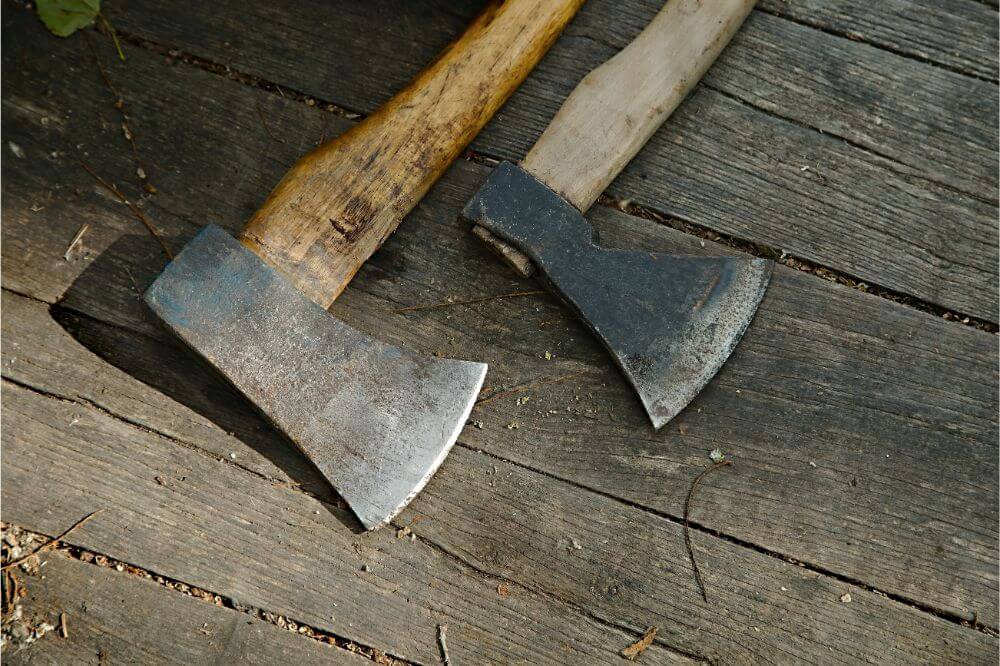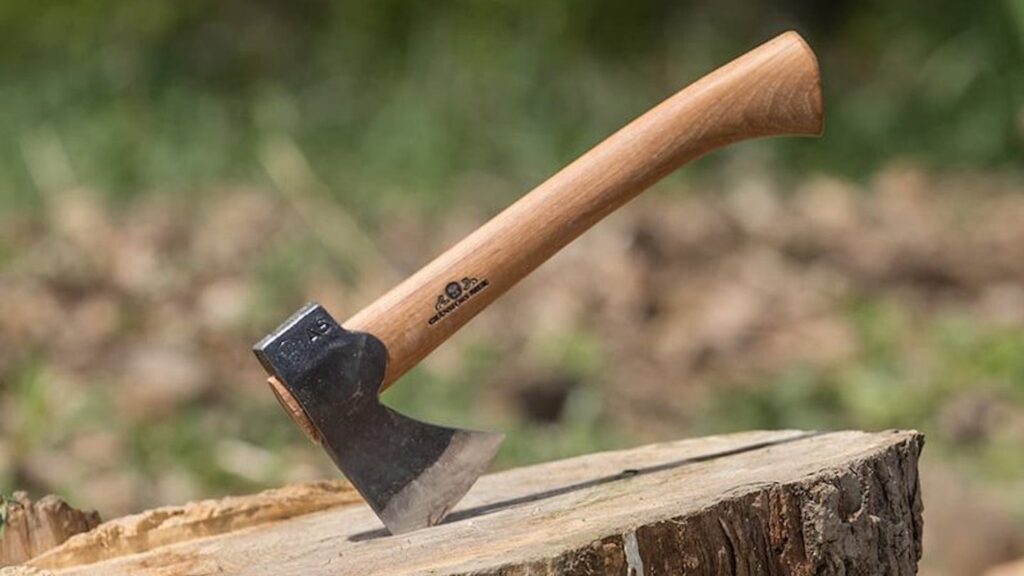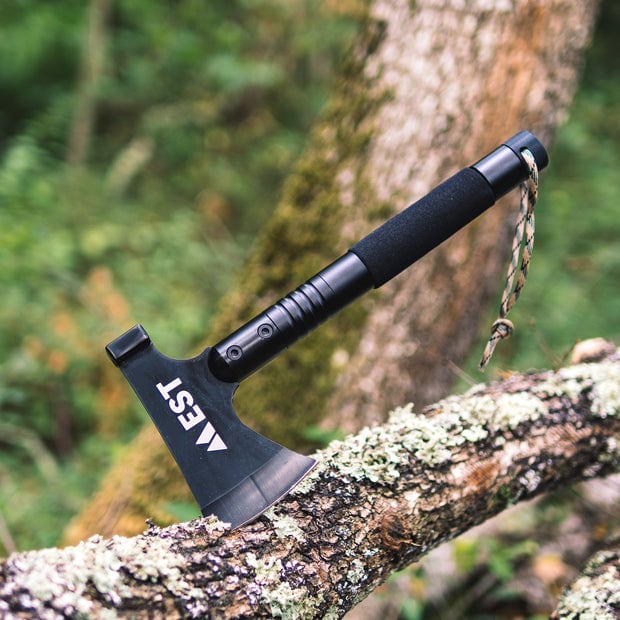
Many believe that hatchets and axes are different names for the same tool. However, hatchets and axes are two very different tools. They’re used for various workloads and different things. Don’t get me wrong, they do have similarities, but they also have their differences.
The primary differences between hatchets and axes are in their appearance and purpose. Axes weigh more and are larger than hatchets. Due to their size, axes should be used for intermediate jobs, like splitting firewood.
Looking at the similarities between hatchets and axes, it’s easy to understand why and how people mix these two tools up. But once we go over the differences between these two, you’ll never mistake one for the other again. Keep reading Hatchet vs Axe: Is There a Difference? for more information!
Before we begin, are you looking for some general information on tools like miters saws, chainsaws, table saws, etc.? Check out our complete resource guides on Miter Saws, Table Saws, Chainsaws, Band Saws, and Circular Saws.
What is a Hatchet?

In many ways, hatchets do look like axes. However, they’re used for very different projects. Hatchets are most often used by carpenters, campers, or roofers. The best way to look at a hatchet is like a small axe. Hatchets come with a smaller handle and a sharp blade.
If you’re looking to purchase a hatchet and want to choose the best, you will have to look at the weight and material of the blade and the material and length of the handle.
What is an Axe?

If you’ve been shopping for axes, then you’ve probably seen different companies claiming that they have the best axe or axes on the market. In reality, most of these axes are not unique. To know what’s the best axe for you, you will need to know ahead of time what kind of tasks you will be completing.
Finding the best axe for you can be tricky even if you know what kind of tasks you’ll be completeing because there are so many types of axes available. There are throwing axes, double-bit axes, Viking axes, etc. So what’s the difference between the three of them?
- Throwing Axes are axes that are most commonly used in competitions. There are a wide variety of different throwing axe competitions that you can participate in.
- Double-bit axes are normal axes, they’re the first thing that comes to mind when you think of an axe, but they have two blades at each side of the head.
- Viking Axes are mostly used for decoration. They come with a Viking design and can’t be used for woodworking because they’re made with a low-quality head/blade.
Axes come with a long handle, and at the top of the handle, they come with the head. The axe head has a blade that is used to cut down trees and cut wood. The axe head is fitted to the handle exactly like hammers.
Hatchet vs Axe: Similarities
There are many similarities between hatchets and axes, which leads a lot of people to think they are the same tool. The two primary similarities between the two are:
- Appearance – both hatchets and axes are traditionally made of a steelhead that has a sharp edge attached to a composite or wood handle.
- Purpose – Both a hatchet and axe are tools used for cutting wood.
But even though hatchets and axes look alike and perform the same basic functions, they are two different tools. Meaning it’s both useful and essential to understanding the differences between them.
Hatchet vs Axe: Differences
Interestingly enough, the main differences between hatchets and axes are the same areas where their similarities (listed above) lie. Axes are better for chopping jobs like splitting wood, while hatchets are best used for light chopping.
You can also easily tell the difference between a hatchet and axe if you look at specific parts of their appearance:
- Size – An axe will be hefty and quite long. On the other hand, a hatchet will comfortably fit in one hand. The best thing we can compare it to is a hammer. If you can easily slip it onto a belt holster, then it’s a hatchet.
- Shaft Design – Axe shafts aren’t usually angled but instead meet the head at nearly a 90-degree angle. Hatchet shafts tend to curve forward, which puts the head almost flush with the handle’s forward-most point.
- Head Shape – Heads on axes are usually larger and taper slightly from the bit to the opposite end of the head. Hatchets generally have narrower heads with a large bit and small body. This creates a drastic taper.
Unless you have the two tools to compare side-by-side, your best bet to tell the difference between a hatchet and axe is to look at their size.
Axes
The most popular axe is a hand axe, also known as a camping axe. These axes are roughly two-thirds of the size of a regular axe but twice the size of a hatchet.
Their size means that they have less striking power than full-size axes but more versatility in terms of cutting angles. But on the other hand, the longer shaft on hand axes means that they are less versatile than hatchets.
Hand axes are often used for activities such as:
- Splitting firewood
- Felling small trees
- Chopping small lumber
There are different types of hand axes depending on what you intend to use them for. For example, a hand axe used for carpentry would look different than one used for forestry. The variety among hand axes is lesser than the variety among regular axes. This is due to specific activities, which a standard axe would be the better choice.
With all of that being said, they’re still the most popular axe for campers. They are perfect for turning small trees into firewood. When choosing a hand axe, pay attention to the thickness of the shaft. It should not be thicker than the axe head. It’s also wise to test the weight and heft of the axe to make sure it’s well-balanced and lightweight. Hand axes should be about 2 Ibs.
Hatchets
Hatchets are smaller in girth, length, and size than hand axes. Because of their size, they are ideal for smaller chopping projects. Activities that the hatchet is most useful for are:
- Chopping small branches off trees
- Splitting pieces of firewood
- Cutting back small to medium bushes
- Felling saplings and tiny trees
Though their size limits it to light work, it makes up for it with several other benefits like:
- Easier to use, carry, and store
- More versatile and maneuverable
- Require less energy and force
If you need something primarily for work in your backyard, then a hatchet is probably the best choice for you. Their size and versatility make them a popular choice over full-size axes and even hand axes. Usually, hatchets have a hammer head on the opposite side of the bit. The bit is only for chopping and cutting purposes, and the hammer head is used for striking.
Wrapping Up
There is Hatchet vs Axe: Is There a Difference! We hope this article helped you understand the difference between a hatchet and a hand axe! Do you prefer one of these over the other? Do you own a hatchet or an axe? If not, are you considering purchasing one now? Please feel free to leave a comment; we would love to hear from you!
Did you enjoy this article? Check out some other articles I have written:
- What is Torque: Conversion Chart and Calculator Included
- Metric vs. Imperial – Conversion Charts Included
- US Screw Sizes – Conversion Charts Included
- 8 12×16 Shed Plans You Can Build Today
- Different Types of Axes and How to Use Them
- 30 Outdoor Yard Games for Kids and Adults
- 30 Outdoor Arts and Crafts for Kids
- 33 Super Easy And Clever DIY Projects to Do at Home
- The Top 10 Business Credit Cards for Small Businesses
